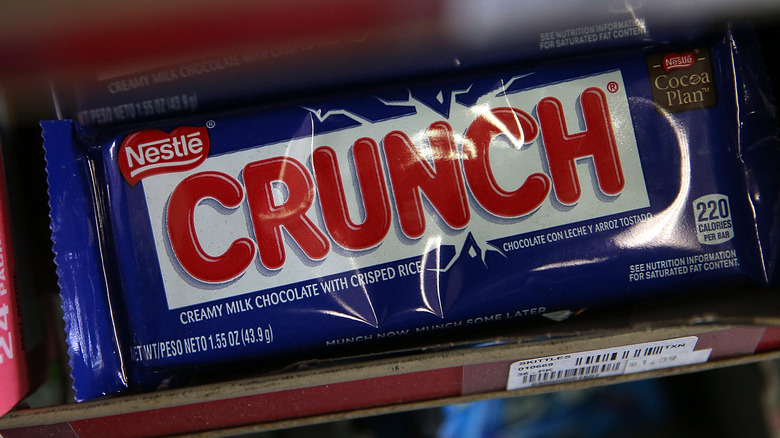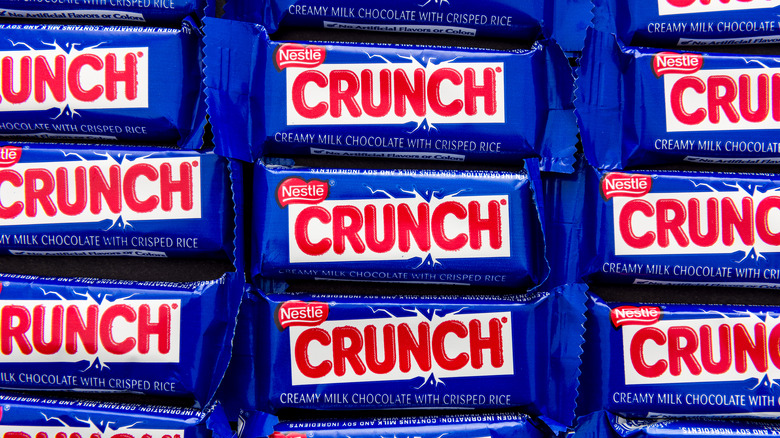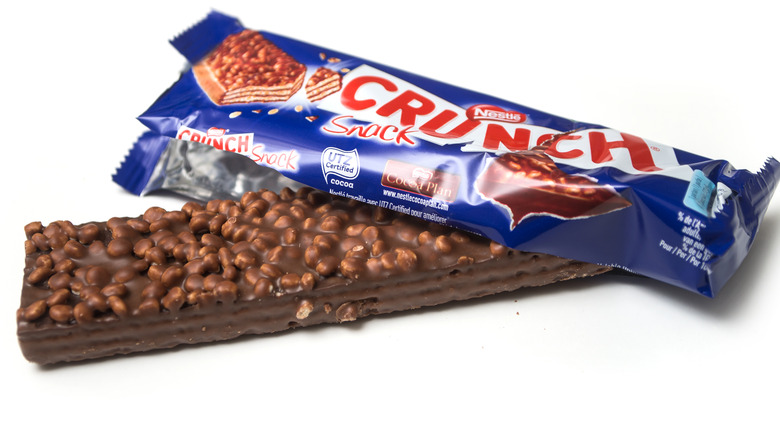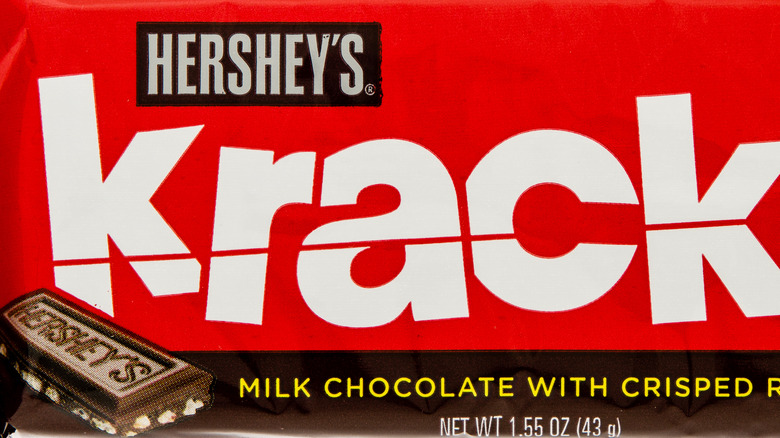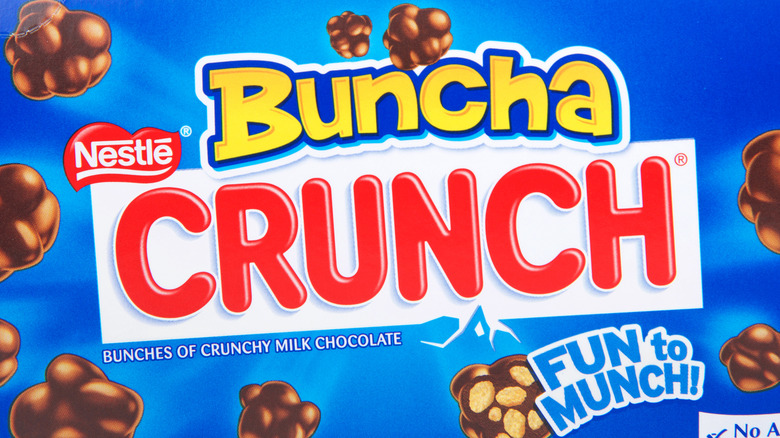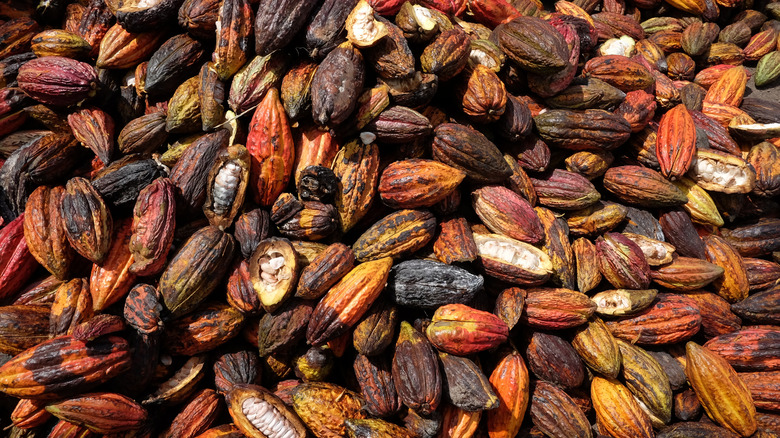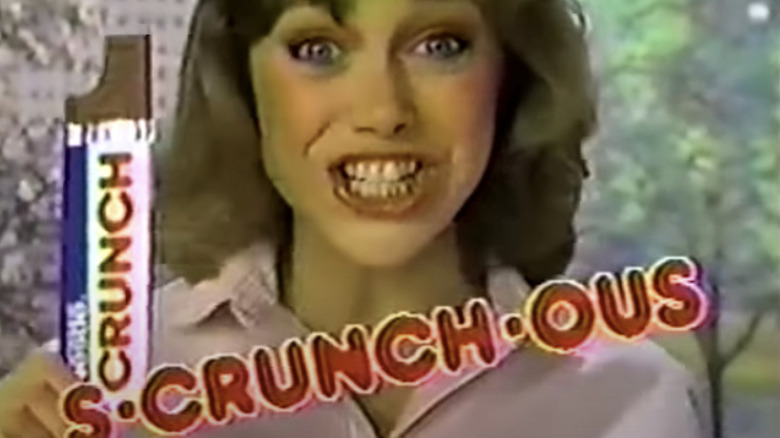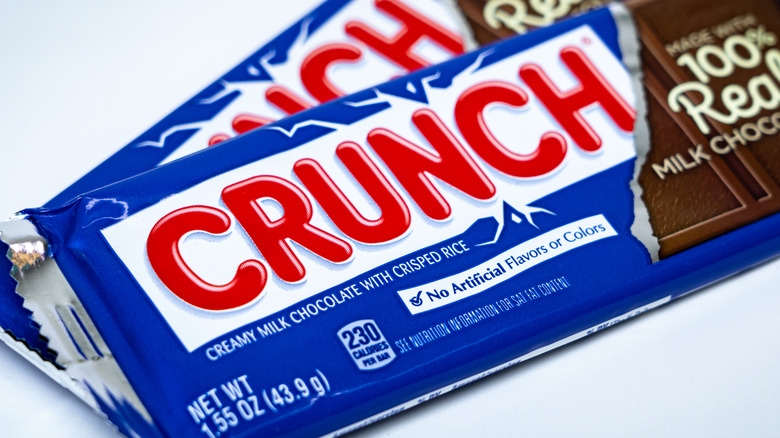The Untold Truth Of Crunch Bar
We may receive a commission on purchases made from links.
After Hershey, with its flagship solid rectangular chunk of sugar, milk, and cocoa proved the commercial viability of chocolate bars, the next stage in candy evolution was the "combination bar." In layman's terms, that means "chocolate with something else complementary in there," be it nougat, caramel, peanuts, or almonds, for example. In the case of the Crunch Bar, manufactured and distributed by milk chocolate originator and popularizer Nestlé since 1938, the special ingredient is rice — cooked, puffed, and popped. Then it's enrobed in chocolate to create a bar that's sweet and creamy and a little bit crumbly, providing a satisfying crunch with every bite.
For more than eight decades, the Crunch Bar has been one of the most popular and bestselling chocolate bars in both the United States and around the world. Both its origins and history are alternately fascinating, innovative, and controversial. Here's a look back on the crispy life of Nestle's Crunch.
Who invented the Crunch Bar?
According to What's Cooking America, the Michaud family of Switzerland helped develop milk chocolate, and were active in a company that would eventually merge with Nestlé. Per Jim Farfaglia's book "Nestlé in Fulton, New York," Maurice Michaud helped create the Nestlé Crunch bar, too. He worked at Nestlé's main production facility in upstate New York in the 1930s, and according to his great-niece Yvonne Mace, Michaud would bring home chocolate pieces from the factory, warm them up, add Rice Krispies, and allow the concoction to cool and harden into chunks. His family loved them, and one day he brought some into the factory to share with coworkers. "Everyone from line workers to plant managers wanted the recipe," Mace said, explaining the inspiration for what would become the chocolate-and-puffed-rice Crunch Bar.
While the Nestlé factory enjoyed a collaborative culture that welcomed new ideas, that could be an apocryphal family story. Michaud's kitchen tinkering may or may not have directly led to the Crunch Bar, but there's one big reason why Nestlé went large scale with cooked rice: It was much cheaper than other chocolate additives, like nuts or caramel. Rice was exceedingly inexpensive, allowing Nestlé to expand its offerings while also keeping production costs very low.
How the Crunch Bar gets its crunch
Nestlé's Crunch Bar would just be a block of solid milk chocolate that didn't make a crunch sound at all were it for the puffed rice inside. When Nestlé started making Crunch Bars at its New York State production facility in the late 1930s, according to Jim Farfaglia's book "Nestlé in Fulton, New York," the company sourced its puffed, crisp rice, all cooked and ready for chocolate encasement, from the Van Brode Milling Company of Massachusetts, which, according to Mr. Breakfast, produced a line of rice-based breakfast cereals. But as the worldwide popularity of the Crunch Bar grew over the decades, Van Brode often had trouble meeting Nestlé's immense need for puffed rice. On occasion, they'd even just truck in bulk amounts of Kellogg's Rice Krispies to the Nestlé factory.
In the 1960s, Nestlé began to explore the possibility of puffing its own rice in-house. The problem, over many trial runs, was that the rice wouldn't come out right. "They were working on a two-step process of cooking rice with steam and then drying it to a crispy texture," plant supervisor Dave O'Bryan said. "The rice came out a mess." Another problem: volume. Nestlé calculated that it needed to produce 1,000 pounds of crisped rice an hour to meet the demand for Crunch Bars. By 1981, Nestle's newly established Crisped Rice Department had perfected and sped-up its methods to the point where it could churn out 3,000 pounds of perfectly puffed rice each hour.
There's very little difference between Crunch and Krackel
If the old adage "imitation is the sincerest form of flattery" is true, then Nestlé theoretically collectively blushed when fierce competitor Hershey released a product that's a near-complete replica of its Crunch bar ... less than a year after the predecessor hit the market. According to Nestlé USA, Nestlé Crunch arrived in 1938 and sold for five cents, consisting simply of a milk chocolate bar loaded with crispy, puffed rice pieces. "Crackle" is a synonym for "crunch," and both are examples of onomatopoeia, a word that imitates the sound the thing makes, in this case, puffed rice being chewed, and Hershey creatively spelled the former to get Krackel, the name of its milk chocolate and puffed rice bar, which, according to Snack History, made its tasty debut in 1938, barely on the tail of Crunch. (One difference: Krackel contained peanuts initially, dropped from the recipe by 1941.)
Nestlé seems to have eventually won the standoff, with Crunch an enduringly popular candy bar, while in the '80s, according to USA Today, Hershey discontinued full-size Krackel, relegating it to just one of the varieties in its bags of miniatures.
Some Crunch Bar spinoffs worked, others didn't
The Crunch Bar isn't just a famous and famously tasty chocolate treat — it's also a well-known brand, meaning it's been a franchise-builder for creator Nestlé. Several Crunch offshoots took hold in the marketplace, filling overlooked niches, while other attempts have flopped hard. Bars of chocolate tend to not sell well at movie theaters, where the snacks are bite-sized or suited to repetitive eating — like popcorn and Twizzlers. Crunch entered the concession stand market in 1994 with Buncha Crunch — a box full of dime-size crispy rice clusters coated in chocolate. According to Snack History, Buncha Crunch was only available in movie theaters for nearly two decades, until they popped up in grocery stores in 2012. And the Crunch White — puffed rice and white chocolate — is still around after decades, if a bit hard to find. The Crunch Crisp, a bar with chocolate, crisped rice, and wafers, a la Kit-Kat, didn't live past the 2010s (per Reddit), nor did the coffee-infused Crunch Mocha (per Candy Critic).
Crunch Bars used to be made by child slaves
According to The Guardian, in 2001 Nestlé signed the Harkin-Engel Protocol, an agreement by cocoa companies to end child labor and child slavery on African cocoa plantations. But in 2005, Nestlé (along with food giants Cargill and Archer Daniels Midland) faced a lawsuit, alleging that it still did business with exploitative farms. In the suit, three plaintiffs testified that they had been forced into service in cocoa farms in Ivory Coast, where they worked 14 hours a day and routinely suffered beatings and other forms of abuse.
Nestlé promised to root out child labor, and in 2013 publicly touted the Nestlé Cocoa Plan, a "global initiative to help improve the lives of cocoa farmers and the quality of their products while also assuring a sustainable cocoa supply" into the future. Specifically, by the end of 2013, Nestlé promised that every Crunch Bar it produced would be made from chocolate certified by UTZ, an independent sustainability and labor watchdog group.
However, according to a 2015 Nestlé-commissioned report by the Fair Labor Association, more than two dozen workers under the age of 15 were found working at Nestlé-affiliated plantations in Ivory Coast in 2014. In 2021, per Reuters, a lawsuit filed by former child slaves from Mali, made it all the way to the U.S. Supreme Court. The panel ruled 8-1 in favor of Nestlé and Cargill, because none of the alleged human rights violations had taken place on American soil.
The Crunch Bar inspired memes
The Crunch Bar is closely associated with its television advertising jingle, an earworm that started burrowing itself into the collective consciousness in the 1980s via commercials featuring people of various ages enthusiastically biting into a bar (with a very loud and artificial crunch sound) while emphatically singing the tune. It goes like this: "Chocolate is s-crunch-ous / when it crunches / that's why I love Nestlé Crunch."
Many years after Nestlé retired the ad, that mixture of nostalgia and widespread familiarity (advertising a well-liked product) could only lead to memes. According to Know Your Meme, Willie J, a user of the now-defunct video sharing platform Vine, edited and posted in September 2016 a vintage '80s Crunch Bar commercial, replacing the "crunch" with the sound of a hand slapping a face. Between Vine and YouTube, the clip amassed more than 10 million views. Willie J also inspired a minor internet sensation, with other intrepid video editors taking out the crunch noise in favor of things like found footage of a woman delivering a sucker punch, a child eating chips, and a man being thrown from an ejector seat. Three years after the initial meme hit, the Crunch jingle became a TikTok fad, with the sound of biting into the bar added to videos of things breaking or people falling.
The Crunch Bar is a Ferrero product now
The Crunch Bar has been an all-American candy for more than two-thirds of a century, one of the most famous products ever put out by Nestlé, helping the company grow from a small chocolate company to a worldwide food conglomerate. The average person probably still refers to the Crunch Bar as a "Nestlé Crunch," even though that's not an entirely accurate label anymore.
In 2018, The Ferrero Group purchased Nestlés entire American candy business for $2.8 billion. Founded in Italy in the 1940s, according to USA Today, Ferrero isn't a household name at the level of Nestlé, but it's one of the world's biggest chocolate and confectionery companies, best known stateside for its hazelnut-based Nutella spread and golden-wrapped, hazelnut-based Ferrero Rocher bonbons. The acquisition granted Ferrero control of more than 20 well-known candy brands, including Butterfinger, 100 Grand, Raisinets, and Baby Ruth. In 2020, per Candy Industry, Ferrero updated Crunch packaging on all sizes and forms of the famous chocolate-and-rice candy, dropping the Nestlé designation entirely, meaning the Nestlé Crunch is now just plain Crunch.
